A Silver Paint Shoot-Out
There are Many Uses for Different Types of Silver Paint During a Project. This Will Give You a Head Start On Your Shopping.
Editor’s note: As you know, this is Auto Restorer’s 25th Anniversary and we’ve been emphasizing the color silver since the beginning of the year. In keeping with that approach we decided, with the help of Jeff Lilly Restorations, to compare a group of silver spray paints that can be very useful in vehicle restorations.
WHILE CARS AND trucks require a variety of paints and shades, silvers play a big part when building your ride. So we will discuss what shades work best with natural aluminum parts such as intakes, alternators, A/C compressors, etc. Furthermore, you face the same dilemma with cast iron parts as choosing the correct shades makes the difference in looks and longevity. At our shop we have an array of aerosols we use to solve these problems and we’ll be testing 18 silver shades here to help you pick the right products for your restoration project.
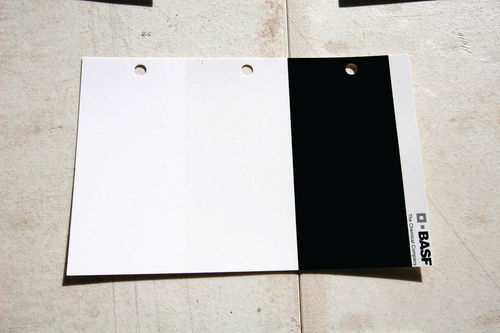
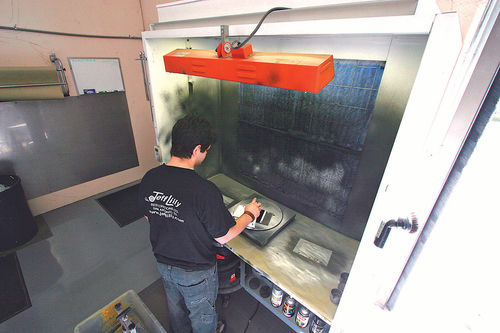
But before we begin, there are a few points we should cover:
Shaking aerosol paint is very important. Some brands settle out more than others and some paints mix up quicker than others. Cast iron silvers are especially stubborn due to the heavy pigments which allow heat tolerance. In addition, a cold can does not spray well and can clog up the nozzle resulting in poor performance.
We usually have no problems spraying during the summer months in Texas when it is 90-100 degrees. Our winters here in San Antonio generally range from 30 to 60 degrees which is not that cold compared to northern states where it can really affect the spray quality. So warm up any can for the best results.
Also, the Tornado by Blair is the only shaker I know of with a hole for holding an aerosol can nozzle.
As for a primer, if you need more adhesion between a paint and bare aluminum or steel, before you put down any of the silvers, excluding high heat products like cast iron, etc., then Tempo Aviation Zinc Chromate Primer is the best you can find in an aerosol can. Aviation sources like Falcon Crest and many other suppliers have it.
Photo 1. Shannon Lilly is seen with a number of the paints that were used in this comparison.
Photo 2. Apples to apples comparisons are the only true test. We use BASF spray cards to test colors for coverage or coat quantity needed. They also give you a consistently smooth panel to determine if the metallic separation is what you are looking for and the overall shade is satisfactory. You can purchase this and other styles like DuPont’s checkerboard sprayout at most auto paint stores. Remember to test spray twice and spray the part once!
Photo 3. Shannon is spraying in our mechanic’s small parts detail booth. An exhaust fan for adequate ventilation is important when spraying any kind of paint. Notice the infrared orange heater. This warms up the parts and the cans before spraying which provides consistent results. If your parts are cold the paint can run and/or take too long to provide proper coverage, so be aware of the surface temp and seek a minimum 70-degree parts surface temperature if at all possible.
Let’s Get Started With the Paints
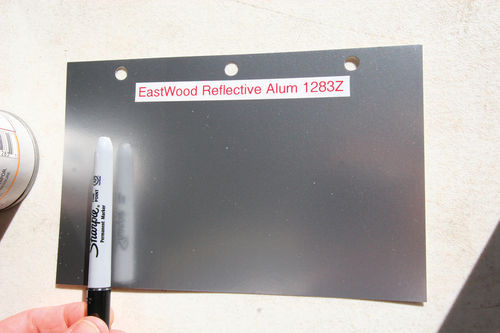

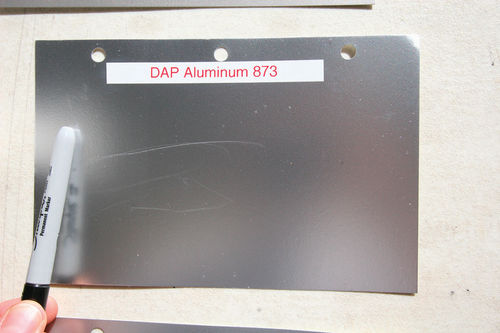

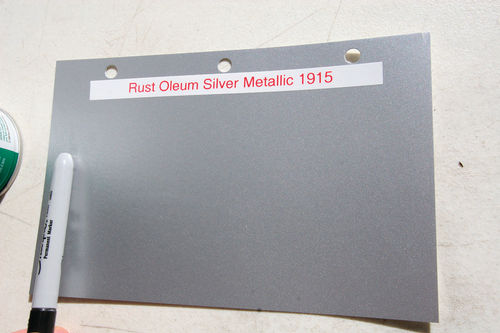


Photo 4. Eastwood 1283Z Reflective Aluminum. As seen in the reflection of the Sharpie pen it is a good candidate for reflection paints. These types of silvers generally are used for dash parts that originally were plastic chromed and taillights or bulb reflection. This brand has a very nice spray with a super fine mist and it covers well in about two to three coats. Reflective paints are not the most durable and if clear coated a dulling effect will take place, so be sure to test if you opt for clear protection.
Photo 5. Rust-Oleum 7718. This is the most reflective paint I have seen out of an aerosol can. As shown by the Sharpie pen reflection, it is pretty much a mirror. It has a very narrow spray pattern, approximately one inch wide. You have to be careful spraying odd shapes with this stuff as you can get runs if you’re not patient. It covers well with a smooth spray and three coats usually gets the job done on most surfaces.
Photo 6. DAP 873. This paint flashes in a slow dry time. We use this to duplicate original Cyanide Cadmium found on a lot of classic vehicles as it is the closest I have ever seen that looks like real cad plating. Its durability, like that of most reflective paints, is on the low side as seen in the fingernail scratch test across the test panel. Be very careful during the assembly of parts to avoid marking the surface. It does harden up somewhat after it sits for a couple of days. There is quite a bit of reflection, as seen.
Photo 7. Rust-Oleum 1915. This paint is considered in the Reflective zone also but a bit more dull then the three previous paints as seen in the Sharpie reflection. All of our test results were photographed in direct sunlight. In the shade they darken a bit, the way most under hood parts will usually be seen. We photographed them this way to show you the metallic size of each paint. Viewed in this lighting you will know if you can live with it or not. It has super fine particles and a decent spray. It covers in three to four coats.
Photo 8. Tempo 1140. The heat range is 250° F. This paint mottles quite a bit during spray out and has a slow flash/dry time. The adhesion is excellent as is the case with all Tempo aircraft aerosols. It has a certain look that can be used for a variety of parts if you can overcome the spray out problems. There’s some reflection as seen with Sharpie pen.
Photo 9. Eastwood Ti-coat 34127Z. Fast dry with good coverage, fuel- and solvent-resistant and a 300° F heat tolerance. It’s a cool-looking paint formulated to look like titanium. We have not found it to match anything we generally build in our shop. But you never know what we might have to match in the future. Keep your options open!
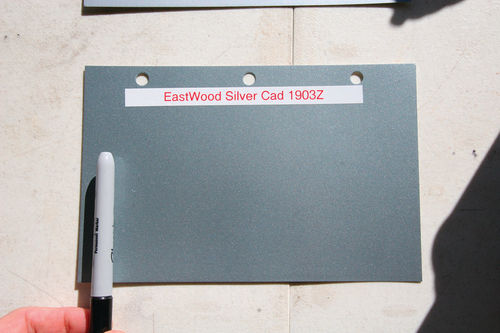
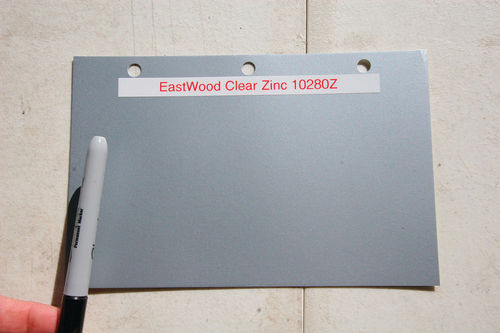
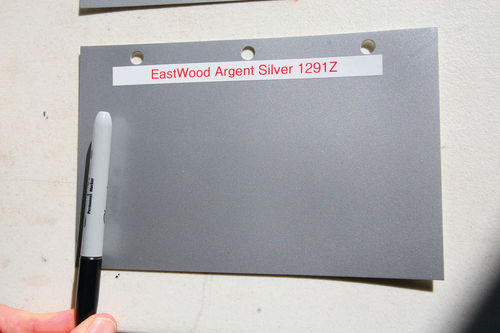

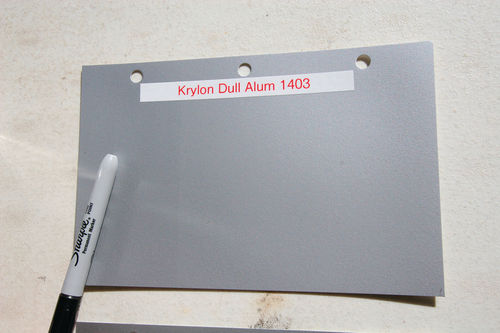
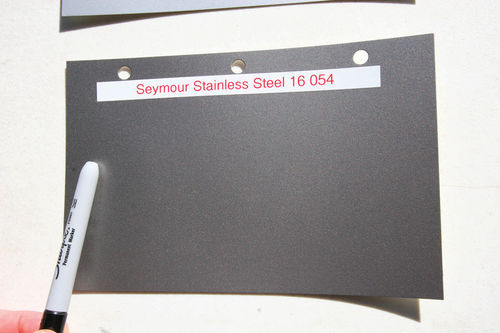
Photo 10. Eastwood Silver Cad 1903Z. This paint has a blue tint! I am not sure what cadmium this will duplicate but it does not match up to anything we have seen in our shop. It is very transparent which means it takes many coats to cover. As seen, there’s very little reflection with the Sharpie.
Photo 11. Eastwood Clear Zinc 10280Z. This clear zinc color also has a slight bluish tint. Still not sure where this would be used for duplicating color surfaces of parts on the market but having an arsenal of silvers to get your machine looking just right is mandatory. It sprays fair but needs a final mist to get good metallic separation with no mottling.
Photo 12. Eastwood Argent Silver 1291Z. A good spray and excellent flash/dry time, and covers quickly. This is very close to many muscle car wheels, GM especially. A nice shade that could be used on many different parts of your ride.
Photo 13. Eastwood Detail Silver 1285Z. Excellent spray covers very quickly in one to two coats. It’s a nice shade for many parts. We use it for some interior parts.
Photo 14. Krylon Dull Aluminum 1403. This is the standby for aluminum intakes, alternators etc. It looks good, covers great and is cheap to buy. You must apply a final mist as it will tend to mottle a bit. As seen, there’s only a moderate reflection.
Photo 15. Seymour Stainless Steel 16- 054. This sunlit photo shows a bit of metallic but in most instances parts sprayed with it will be in lower light such as under hood, on suspension systems, drive shafts, etc. It looks like bare steel. We use this stuff a lot.
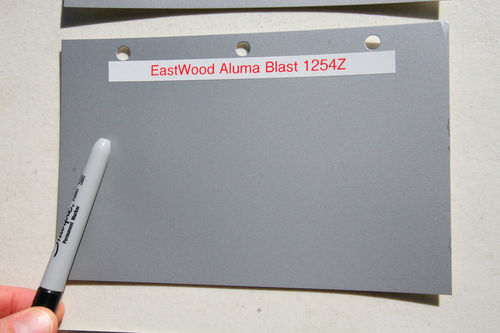
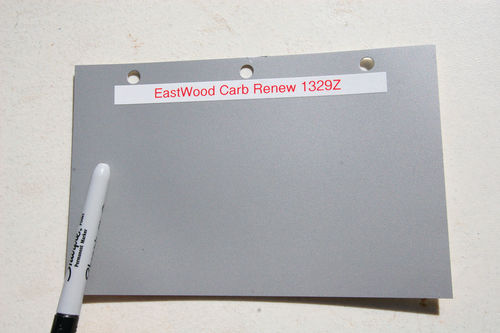
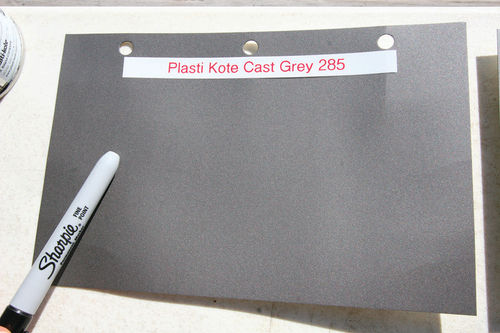
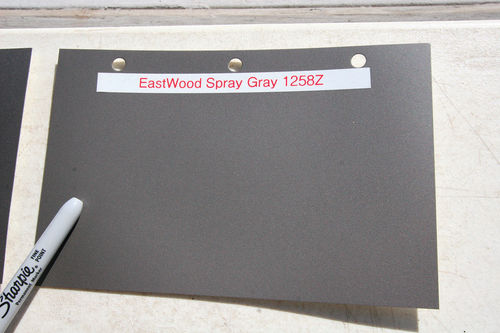
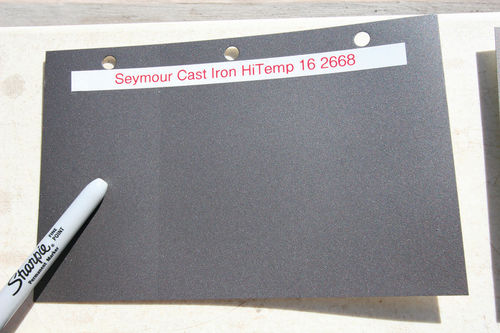

Photo 16. Eastwood Aluma Blast 1254Z. Sprays very nice and flashes off quick. This is a close match to Krylon’s Dull Aluminum 1403. You may want to get a can of each and compare with your parts. Keep in mind that brand-new intakes from different manufacturers will have different shades. A restored intake that has been either glass beaded, aluminum oxide blasted, pecan or walnut shell tumbled, acid washed, etc. changes the way an aluminum shade looks so you have to have a paint arsenal to get things dead on.
Photo 17. Eastwood Carb Renew 1329Z. This stuff comes in small baby cans and sprays very light. Aside from that it is almost a dead-on match to most carburetor bodies. We rarely use it because we rebuild and refinish all of the natural metal on our carbs as we do not want any streaking from gas during use. For someone on a budget or if you have an older or rare set of carbs that you like the look of and they are beyond taking the natural finish to perfection then consider it. It has NO metallic look to it whatsoever.
Cast Iron Silver Paints
Now we’ll move on to the cast iron silvers used on exhaust manifolds, master cylinders, suspension parts and anything else you may want to consider.
Photo 18. Plasti Kote 285. I like this paint as it sprays very nice and is inexpensive and also covers great. It does not tolerate high heat, with a maximum of 500° F, so using it on headers or a cast iron exhaust would not be a consideration. For all other parts it’s a good pick.
Photo 19. Eastwood Spray Grey 1258Z. It sprays nice and covers real quickly but the heat tolerance is very low so it will not take the high heat associated with exhaust manifolds. It’s slightly darker then the Plasti Kote but a nice look nevertheless.
Photo 20. Seymour Cast Iron 16-2668. You need to shake the daylights out of this stuff for it to spray well. The metallic does not show in the low light present for most parts as they’re seen on a car. It takes the heat very well so exhaust manifolds are no problem. We have used it for years. Warm the can in the winter months in order for it to spray decent or you will be bummed.
Photo 21. VHT Cast Grey Flame Proof. This stuff will go up to 2000° F but they recommend curing it by running your engine or oven heat! That’s a lot of work for most people, but that is what it will take. It can tend to clog and sprays a bit poorly but looks good once you get used to its spraying habits.
We have our favorites but they all can be used if the shades are what you want. You can find these paints at familiar spots such as Eastwood, Lowes, Home Depot, Walmart, etc. Call around to your local suppliers and experiment for the best results.
Jeff Lilly is a veteran restoration pro and a longtime contributor to Auto Restorer. And now his son, Shannon, has joined him. You can reach their shop at: Jeff Lilly Restorations, 11125 F.M. 1560 San Antonio, TX 78023; jefflilly.com; .
















